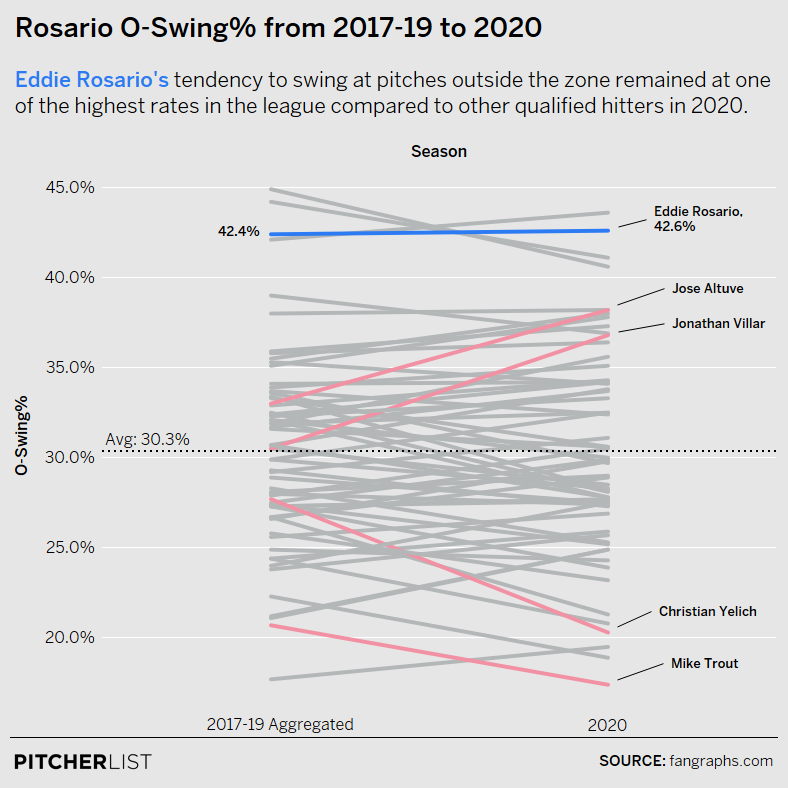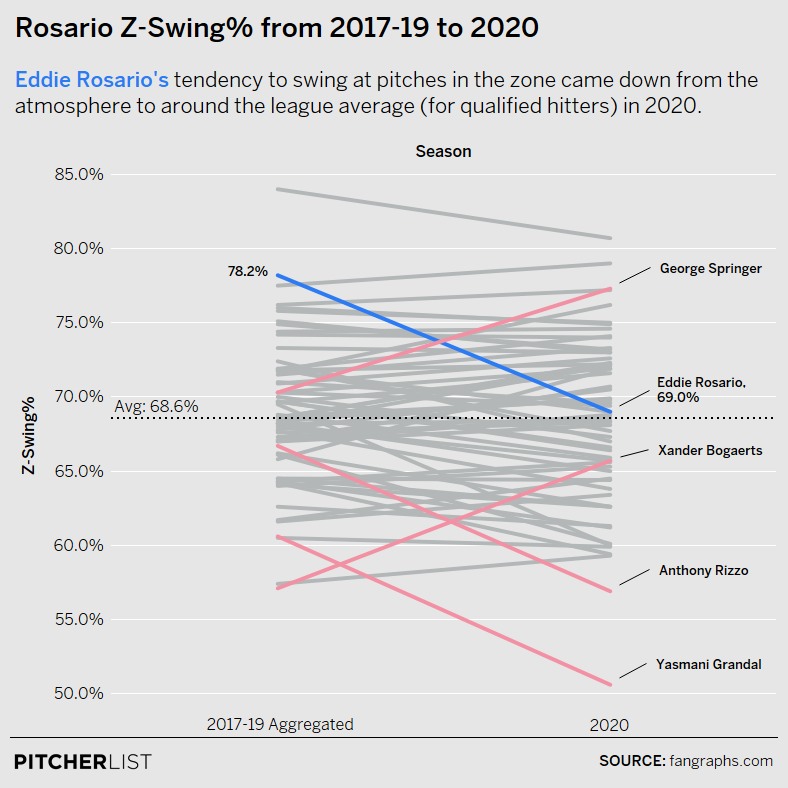Since becoming a full-time player in 2017, Eddie Rosario has been one of the more consistent hitters in baseball. From 2017-19, he became known as a high-average hitter with decent pop, averaging a .284/.317/.495 triple slash, 27 home runs and seven steals a season.
During that time period, his full season batting average was never lower than .276 or higher than .290. While it was clear what Rosario could do swinging the bat, it was also evident that he was almost always going to swing it. Rosario has historically been one of the more aggressive hitters at the plate. That changed a bit last year. As Josiah DeBoer noted for us last August, Rosario was more patient to start the season in 2020. We’ll take a deeper look into the 2020 results and try to come to a determination of what it means for Rosario going forward.
Career vs. 2020
An outline of Rosario’s stats will give an idea of just how different — or not different — he was in 2020 compared to his prior seasons.
| Stats | 2017 (151 games) | 2018 (138 games) | 2019 (137 games) | 2020 (57 games) |
| AVG | .290 | .288 | .276 | .257 |
| SLG | .507 | .479 | .500 | .476 |
| HR | 27 | 24 | 32 | 13 |
| wRC+ | 117 | 114 | 103 | 110 |
| BB % | 5.9 | 5.1 | 3.7 | 8.2 |
| K % | 18 | 17.6 | 14.6 | 14.7 |
We’ll start with 2017, even though Rosario made his debut in 2015. Everything mentioned in the introduction rings true. Rosario’s batting average and slugging percentage remained in the same all ballpark for all four seasons (though the average has been steadily declining), and his home run pace, although higher the last few years, isn’t too far off what we saw from him in 2017 and 2018. And then there is what DeBoer’s article touched on — Rosario’s walk rate ballooned to a career high 8.2 % in 2020. That number is right around the league average and it’s interesting to see that his strikeout rate didn’t suffer. In fact, it was close to the career-best mark he set in 2020. I took at look both Ramon Laureano and Tommy Edman earlier this year, and while it appeared that both hitters were making a conscious effort to draw more walks last season, their strikeout percentage also saw a spike as a result of the deeper counts. The ultimate conclusion was that both hitters should revert back to being more aggressive at the plate. Let’s dig deeper to see if the same should be concluded for Rosario.

Data Visualization by @Kollauf on Twitter
A quick look at the graph above shows that Rosario has historically chased pitches out of the zone at one of the highest rates in the league. From 2017 to 2019, Rosario’s 42.4% O-Swing rate ranked 101st out of 104 qualified batters. Only Adam Jones, Kevin Pillar and Javier Baez chased more balls out of the zone. It makes sense as to why Rosario would want to fix this flaw in his game. His solution? Swing less. During that span, Rosario’s swing rate checked in at 57.2%. In 2020, he dropped that number all the way down to 51.7%. This is still an above-average clip, but much lower than we’ve ever seen from Rosario in the past. Unfortunately, this tactic didn’t seem to help on pitches outside the zone. Rosario’s O-Swing rate remained about the same, checking in at 42.6%.

Data Visualization by @Kollauf on Twitter
The problem compounds when looking at the second graph. While Rosario’s O-Swing rate remained consistent, his swing rate at pitches in the zone dropped from 78.2% — the fourth-highest among qualified hitters — to 69%. Simply put, Rosario was still chasing pitches out of the zone and now taking the offerings he used to do damage on more often. Rosario’s elite contact rates prevented a spike in strikeouts despite these approach changes, but overall, letting the pitches you can drive pass by while still swinging at the pitches out of the zone isn’t the best combination.
A look at a few visuals below give a more thorough look at Rosario’s change and the impact it had on his results in 2020.

Eddie Rosario 2019
We’ll take a glance at Rosario’s swing and take profile for 2019 first. Despite being an aggressive hitter, Rosario does a decent job when it comes to the pitches in the chase and waste zones. He actually did swing at these pitches more often than the league average, but as he is known for his aggressiveness, he also saw these types of offerings at a higher frequency than most. The shadow zone is not his friend and Rosario’s aggressiveness hurt him in this area specifically. His run value on swings on these types of pitches was an ugly negative-11. He did do plenty of damage on pitches in the heart zone and swung at these offerings at an 83% clip, much higher than the league average of 73%. Given that this is the only zone where Rosario had a positive swing value, you can at least see the logic behind him wanting to swing less often in 2020. Let’s see what happened.

Eddie Rosario 2020
The 2020 campaign is a bit of a different story. Although what is happening in the waste, chase and shadow zones is fairly consistent with what we saw in 2019, the main difference between 2019 and 2020 is what is happening in the heart zone. In 2020, Rosario was right at the league average in terms of when he takes and when he swings at these types of pitches. For someone like Rosario, this isn’t a good thing. Essentially, his effort to be patient led to him taking the hittable pitches more often while still swinging at all other pitches at an above-average rate. That’s not going to lead to success. Rosario’s run value on swings in the shadow zone was still an unsightly negative nine, and his swing value on pitches over the heart of the plate, while still positive, decreased dramatically.
As noted above, though, Rosario’s 2020 numbers weren’t too far off what we’ve come to expect from him, but he did experience slight decreases in batting average and slugging. That’s most likely due to him swinging less often at the pitches in the heart zone. Let’s take a look to see if his batted ball data suffered as a result.
| Stats | 2017 | 2018 | 2019 | 2020 | MLB Average |
| Exit Velocity | 87.2 | 87.7 | 89.2 | 87.5 | 88.3 |
| Max EV | 107.5 | 108.1 | 108.6 | 105.0 | N/A |
| Launch Angle | 13.3 | 17.8 | 16.8 | 18.1 | 11.9 |
| Barrel % | 7.4 | 8.3 | 8.5 | 6.2 | 6.4 |
Rosario has never been a massive exit velocity guy, and his numbers in that category have remained about the same over the last four years. He experienced a jump in 2019, but who didn’t? We can chalk that up to the bouncier baseball. A dip in his max EV is a bit concerning and the decrease in barrel rate isn’t too encouraging, either. It’s possible that both can be chalked up to his effort to be more patient. Swinging less often at the pitches he can drive is naturally going to lead to him not squaring up balls as often as previous seasons.
Conclusion
Eddie Rosario has been one of the more consistently bankable outfielders over the course of the last four season. He’s been a steady production of average and home runs and also chips in with a handful of steals each year.
In 2020, he changed his approach at the plate. His increase in walk rate was a bit of fool’s gold — he did take more walks but it wasn’t due to an improved eye at the plate. He was simply just swinging less often. As a result, his production took a slight hit. Despite this, he was still a steady performer and his home run pace was actually a career-best. But he was barreling at around a league average rate after being in the 75th percentile or better in each of the previous three seasons.
Even if Rosario sticks with the more patient approach, it’s likely he will still be a productive hitter. It seems though that it would benefit him to return more to the aggressive hitter that he’s been in year’s past. It will be important to monitor his swing tendencies to see what kind of Rosario we will be getting in 2021. So far, he’s looking more like 2020 Rosario — but with some improvements. His swing rate is roughly the same as it was last season, but his chase rate has decreased to a career-best and his zone swing rate has climbed back close to his career average. This is probably just the result of a small sample, but if this is the beginning of a legitimate improvement, then this could signal a potential breakout from Rosario.
Rosario is also now with Cleveland on a one-year deal. He’s hitting in the middle of the lineup and has a clear everyday role. While Cleveland isn’t the offensive juggernaut that Minnesota was, there should be plenty of opportunities for Rosario to compile counting stats. There is also a good chance that he will run more than he has in previous seasons. Minnesota ranked dead last in steals in 2019 and 2020, so the organizational change could give Rosario more opportunities on the basepaths.
From a dynasty perspective, Rosario is in his age-29 season. He’s likely in his prime right now and should be a productive hitter for the next few seasons. If the 2021 improvements do stick, this could be a buying window right before a potential breakout. The best of Rosario could still be yet to come. If his plate discipline stats are more in line with 2020, production like we saw last season or maybe even another slight decline could be forthcoming. His chase rate and zone swing rate numbers are the stats to monitor to see which player we could be getting. Lastly, it is is also slightly concerning that Rosario only signed for a one-year deal at $8 million this offseason. He seems like too good of a player to not keep finding work, but the market has been tough on some players once they enter their 30s. Overall, Rosario’s above-average but not elite consistency probably made him a slightly undervalued dynasty asset over the last season or two. That alone should make him a soft buy for contending teams — his floor is fairly predictable at this point, even if there is a small decline in the next few seasons. Whether or not he’s a strong buy will depend entirely on how those plate discipline stats stabilize over the next few weeks.
Photos by Larry Radloff & Bryan Singer/Icon Sportswire | Adapted by Michael Packard (@designsbypack on Twitter and Instagram)
